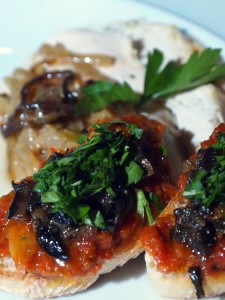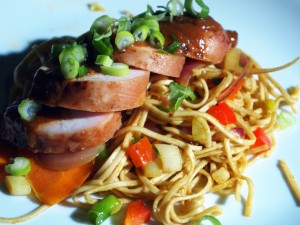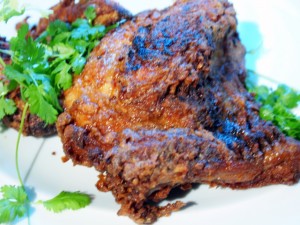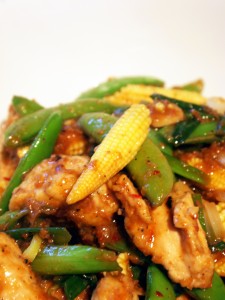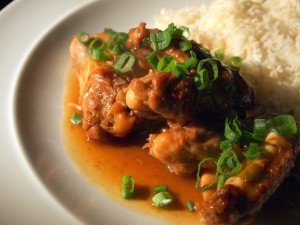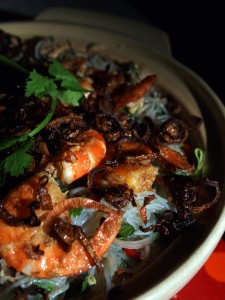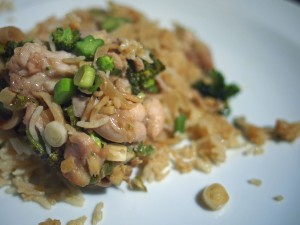
This is similar to a lot of Chinese claypot dishes, and is really worth rolling out on a day when you have guests you want to spend time talking to rather than cooking for. It’s very, very tasty indeed, but it only uses one dish (or a rice cooker, if you happen to have one in the house) and doesn’t require any advance preparation or marinading. You’ll be using the food processor to blitz some chicken thighs into something a bit like a try rough chicken mince. Be careful when blitzing – you want small pieces of chicken, which steam to a really tasty, juicy result, rather than a smooth paste, which steams to a rubbery horribleness. The rice absorbs juices from the chicken along with all its seasoning, making for a really savoury dish.
I’ve been really pleased to see so many oriental ingredients make their way into even some of our…slightly rubbisher supermarkets. I found a jar of bamboo shoots in sesame oil when on an emergency tonic water run to Tesco. They’re great, and if you can track them down they’re well worth using, but if you can’t find them, substitute with canned shoots, rinsed well under the tap. All the other ingredients should be easy for you to get your hands on.
Texture’s a really important part of this dish. If you’re lucky, you’ll get a tasty crust at the bottom of the rice, created by the fat from the stock and the sesame oil which drips to the bottom “frying” the rice at the base of the dish. (Be sparing with the stock when you come to add the chicken mixture to increase the chances of a good crust.) The chicken will be soft from the steaming, and the vegetables, with their lower water content, will cook rather more slowly than the chicken surrounding them, leaving a lovely fresh crunch to things. As ever, use a home-made chicken stock if you have some in the freezer. If you don’t, I’ve had great success recently with the stuff Waitrose have been producing since their partnership with Heston Blumenthal, which is made with some kombu (a Japanese sea vegetable) for an extra umami kick.
To serve two (just multiply the amounts for more people and add an extra 5-10 minutes’ steaming time when you add the chicken for each extra portion) you’ll need:
370g jasmine rice
1 litre chicken stock
2 pieces of ginger the size of your thumb
12 spring onions
6 boneless, skinless chicken thighs
6 cloves garlic
3 tablespoons oyster sauce
2 tablespoons light soy sauce
2 tablespoons sesame oil
1 tablespoons Chinese chilli oil
75ml Chinese rice wine
100g bamboo shoots in sesame oil, drained
100g long-stem broccoli
Choose a Chinese claypot or a heavy saucepan with a close-fitting lid to cook the dish in. (You can also use a rice cooker – see below.) Combine the rice and 750ml of the stock in the pan with two of the spring onions, left whole, and one of the thumbs of ginger, peeled and sliced into coins. Put the lid on and bring the pan to the boil over a medium heat. Turn the heat down low and steam the rice for 20 minutes while you prepare the chicken.
While the rice is cooking, put the chicken thighs in the bowl of your food processor, and pulse gently and briefly until the chicken is chopped finely. Put the chicken pieces in a mixing bowl. Peel and dice the remaining ginger, mince the garlic and chop the rest of the spring onions and the broccoli into little pieces. Throw them in with the chicken, add the bamboo shoots, sesame oil, chilli oil, oyster sauce, rice wine and soy sauce, and use your hands to make sure everything is well combined. (I know, you hate touching raw chicken. Use a spoon if you must, but make sure everything is really well mixed.)
When the rice is ready, it’ll have little holes in the flat surface. Spoon the chicken mixture on top of it, pour over the remaining 25ml of stock, and stick the lid back on. Steam over the low heat the rice cooked at for another 25 minutes, and serve.
If you plan on cooking this in a rice cooker, just cook the rice with the stock, ginger and spring onions under the normal white rice setting, then set it to steam for the required amount of time. If your cooker doesn’t have a steam setting, just set it to “keep warm” when you’ve added the other ingredients, which should provide enough heat to steam the topping, but may take a little longer.

